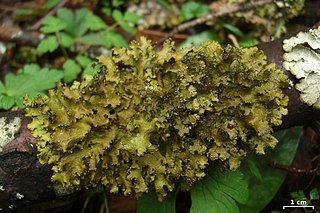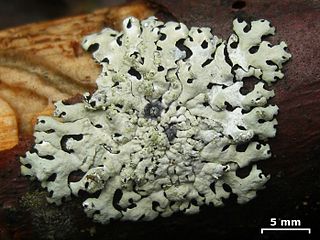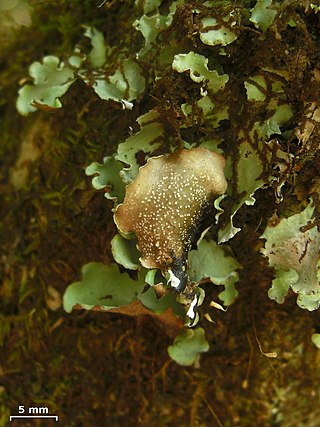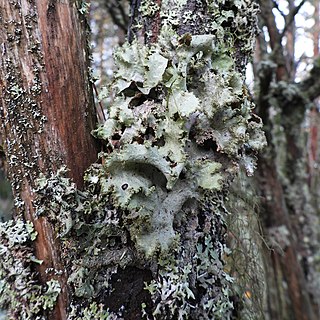
Parmelia is a genus of medium to large foliose lichens. It has a global distribution, extending from the Arctic to the Antarctic continent but concentrated in temperate regions. There are about 40 species in Parmelia. In recent decades, the once large genus Parmelia has been divided into a number of smaller genera according to thallus morphology and phylogenetic relatedness.

The Parmeliaceae is a large and diverse family of Lecanoromycetes. With over 2700 species in 71 genera, it is the largest family of lichen-forming fungi. The most speciose genera in the family are the well-known groups: Xanthoparmelia, Usnea, Parmotrema, and Hypotrachyna.

Pseudevernia furfuracea, commonly known as tree moss, is a lichenized species of fungus that grows on the bark of firs and pines. The lichen is rather sensitive to air pollution, its presence usually indicating good air conditions in the growing place. The species has numerous human uses, including use in perfume, embalming and in medicine. Large amounts of tree moss is annually processed in France for the perfume industry.

Hypogymnia is a genus of foliose lichens in the family Parmeliaceae. They are commonly known as tube lichens, bone lichens, or pillow lichens. Most species lack rhizines that are otherwise common in members of the Parmeliaceae, and have swollen lobes that are usually hollow. Other common characteristics are relatively small spores and the presence of physodic acid and related lichen products. The lichens usually grow on the bark and wood of coniferous trees.

Tuckermannopsis is a genus of foliose lichens in the family Parmeliaceae.

Hypotrachyna is a genus of lichenized fungi within the family Parmeliaceae. According to the Dictionary of the Fungi, the widespread genus contains about 198 species. Hypotrachyna was circumscribed by American lichenologist Mason Ellsworth Hale Jr in 1974.

Cetrelia is a genus of leafy lichens in the large family Parmeliaceae. They are commonly known as sea-storm lichens, alluding to the wavy appearance of their lobes. The name of the genus, circumscribed in 1968 by the husband and wife lichenologists William and Chicita Culberson, alludes to the former placement of these species in the genera Cetraria and Parmelia.

Punctelia is a genus of foliose lichens belonging to the large family Parmeliaceae. The genus, which contains about 50 species, was segregated from genus Parmelia in 1982. Characteristics that define Punctelia include the presence of hook-like to thread-like conidia, simple rhizines, and point-like pseudocyphellae. It is this last feature that is alluded to in the vernacular names speckled shield lichens or speckleback lichens.

Haematomma is a genus of crustose lichens established by Abramo Bartolommeo Massalongo in 1852. It is the sole genus in the Haematommataceae, a family circumscribed by Josef Hafellner in 1984. Commonly called bloodstain lichens, the species assigned to this genus are widely distributed in tropical and temperate areas.
Mason Ellsworth Hale, Jr. was one of the most prolific American lichenologists of the 20th century. Many of his scholarly articles focused on the taxonomy of the family Parmeliaceae. Hale was one of the first lichen experts to incorporate secondary chemistry and technology such as computers and scanning electron microscopy into taxonomic work. Mason Hale published approximately two hundred articles and books on various aspects of lichen biology including taxonomy, anatomy, chemistry, and ecology. Hale also wrote several books aimed at education and increasing accessibility to lichens.
Parmotrema aldabrense is a species of lichen in the family Parmeliaceae that is found in Africa. It was first described by Carroll William Dodge in 1959 as a species of Parmelia. Mason Hale transferred it to the genus Parmotrema in 1974. The type collection was made in the Aldabra Islands, where it was found growing on tamarind. It has also been recorded from Madagascar. The lichen has an olive-buff coloured thallus measuring up to 14 cm (5.5 in) in diameter.
Parmotrema amboimense is a species of lichen in the family Parmeliaceae that is found in Africa. It was first described by Carroll William Dodge in 1959 as a species of Parmelia. Mason Hale transferred it to the genus Parmotrema in 1974. The type collection was made in Cuanza Sul Province (Angola), where it was found growing at an elevation of 1,000 m (3,300 ft); Dodge also noted the presence of the lichen in Cameroon and Uganda. Parmotrema amboimense has a pale olive-buff coloured thallus measuring up to 10 cm (4 in) in diameter.

Parmotrema mellissii is a widely distributed species of corticolous lichen in the family Parmeliaceae. It was first described by Carroll William Dodge in 1959 as a species of Parmelia. Mason Hale transferred it to the genus Parmotrema in 1974. The type collection was made in Saint Helena. Parmotrema mellissii has a pale yellowish-buff coloured thallus at least 12 cm (5 in) in diameter, comprising rounded lobes about 15 mm wide and long. It has been found in the southern U.S.A., the Neotropics from Mexico to Colombia and Brazil, Africa, Asia, Australia and Oceania.

Parmotrema gardneri is a species of foliose lichen in the family Parmeliaceae. It was first formally described in 1955 by Carroll William Dodge as Parmelia gardneri, from specimens collected in Brazil. Emmanuël Sérusiaux transferred it to the genus Parmotrema in 1984. In addition to South America, it is also found in Africa, Asia, and North America.

Cetrelia monachorum is a species of foliose lichen in the family Parmeliaceae. It was first described scientifically in 1930 by Alexander Zahlbruckner as a species of Parmelia. Husband and wife lichenologists William and Chicita Culberson transferred it into the genus Cetrelia in 1977. It is found in Asia, Europe, and North America.
Lichen products, also known as lichen substances, are organic compounds produced by a lichen. Specifically, they are secondary metabolites. Lichen products are represented in several different chemical classes, including terpenoids, orcinol derivatives, chromones, xanthones, depsides, and depsidones. Over 800 lichen products of known chemical structure have been reported in the scientific literature, and most of these compound are exclusively found in lichens. Examples of lichen products include usnic acid, atranorin, lichexanthone, salazinic acid, and isolichenan, an α-glucan. Many lichen products have biological activity, and research into these effects is ongoing.

Platismatia glauca is a common and widespread species of corticolous (bark-dwelling), foliose lichen in the family Parmeliaceae.














